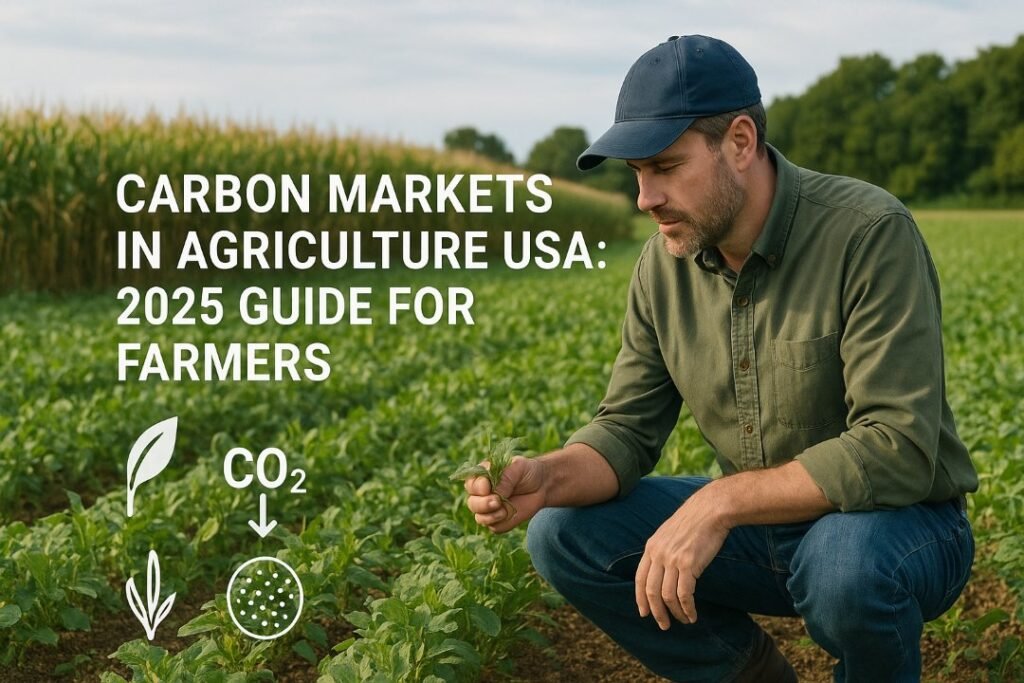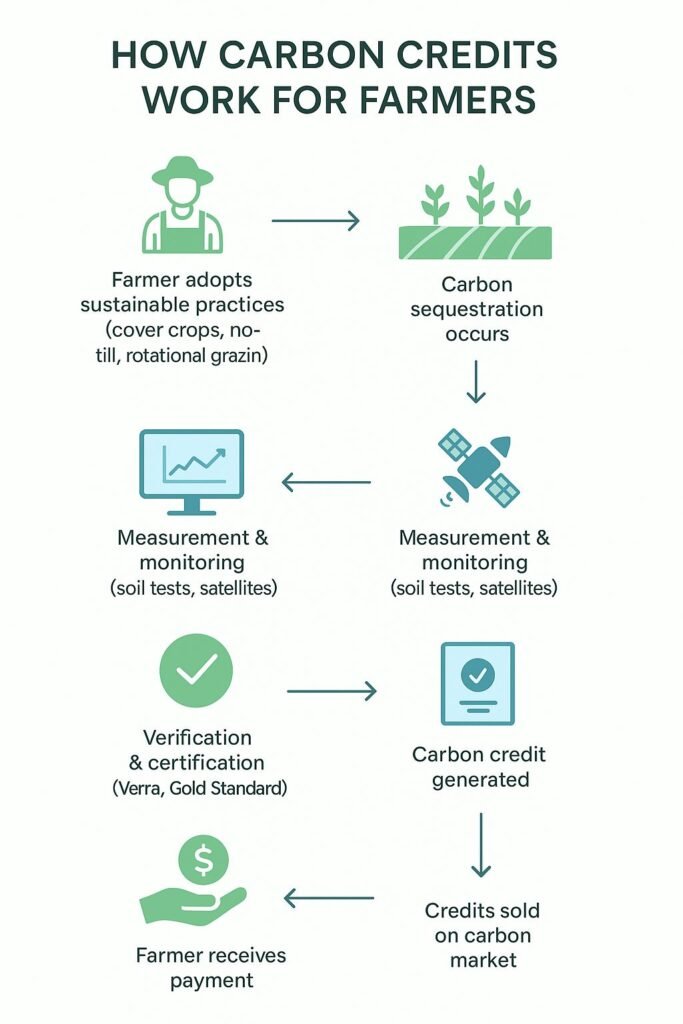
Farmers across the United States are discovering new income opportunities through carbon markets in agriculture USA. By participating in carbon credit programs and payments for ecosystem services, U.S. farmers can earn money while adopting sustainable, climate-smart practices.
Thanks to the growth of carbon markets and payments for ecosystem services (PES), American farmers can now earn money for practices that help fight climate change. In this guide, we’ll explore how these innovative systems are reshaping agriculture in the U.S., how farmers can participate, and what trends to expect in 2025 and beyond.
Carbon Markets in Agriculture USA: How They Work
A carbon market allows companies or governments to buy and sell carbon credits — measurable units that represent a reduction or removal of greenhouse gases from the atmosphere.
In agriculture, carbon credits are generated when farmers adopt practices that sequester carbon in the soil or reduce emissions. These include:
- No-till or reduced tillage
- Cover cropping
- Rotational grazing
- Agroforestry
- Precision nutrient management
Each ton of carbon dioxide (CO₂) captured or avoided can be sold as a carbon credit in voluntary or compliance markets.
According to the World Bank’s 2024 State and Trends of Carbon Pricing Report, the global carbon market value reached over $104 billion, and agricultural participation is rapidly increasing in North America.
How Carbon Markets in Agriculture USA Benefit Farmers
Carbon markets are transforming the economics of farming by creating a new revenue stream for regenerative and climate-smart practices.
Additional Farm Income
The USDA Climate-Smart Commodities Initiative estimates that farmers can earn $20–$40 per acre per year through carbon credit programs, depending on the type of practice and soil carbon potential.
Sustainable Branding
Buyers and food companies are increasingly seeking low-carbon supply chains, rewarding farmers who can prove sustainable management.
Risk Reduction
Adopting carbon-smart practices like cover cropping improves soil health, reduces input costs, and builds resilience to droughts and floods — key climate risks facing U.S. agriculture.
Types of Carbon Markets in the U.S.
| Market Type | Description | Examples |
|---|---|---|
| Voluntary Market | Farmers sell credits to private companies aiming for net-zero goals. | Indigo Ag, Nori, Soil Carbon Co. |
| Compliance Market | Credits traded under regulated government schemes. | California Cap-and-Trade Program |
| Emerging Regional Programs | State or cooperative-level initiatives supporting local producers. | Midwest Climate Smart Coalition, Ecosystem Services Marketplace Consortium |
According to USDA, more than $3 billion has been committed to support U.S. farmers adopting carbon-reducing practices by 2025.
Ecosystem Payments & Carbon Markets in Agriculture USA
Payments for Ecosystem Services (PES) go beyond carbon. They reward farmers for the broader environmental benefits their land provides — such as:
- Improved water quality
- Biodiversity conservation
- Soil erosion control
- Pollinator habitat creation
In PES schemes, farmers are compensated for maintaining or enhancing natural systems that benefit society at large.
Examples of U.S. PES Programs
- Conservation Reserve Program (CRP) – Pays farmers to remove environmentally sensitive land from production.
- Environmental Quality Incentives Program (EQIP) – Provides funding for conservation practices.
- Regional PES Pilots – States like Vermont and Oregon are testing local ecosystem service markets for farmers.
How Farmers Earn from Carbon and Ecosystem Programs
Step 1: Baseline Measurement
Farmers begin with a carbon or ecosystem assessment, measuring soil carbon levels, emissions, and land-use patterns.
Step 2: Practice Adoption
Choose verified practices such as reduced tillage, cover cropping, or rotational grazing that can generate measurable outcomes.
Step 3: Verification & Certification
Data is verified using standards like Verra, Gold Standard, or Climate Action Reserve, ensuring transparency and credibility.
Step 4: Credit Generation & Sale
Once verified, carbon credits are listed on platforms where corporations or investors purchase them to offset emissions.
Step 5: Payment & Reinvestment
Revenue is paid to farmers, who can reinvest in technology, soil testing, or precision agriculture to further improve sustainability.

Carbon Markets in Agriculture USA: Midwest Case Study
In 2024, a group of 120 farmers from Iowa and Illinois joined the Midwest Regenerative Carbon Network, adopting cover cropping and reduced tillage across 45,000 acres.
Within a year, they collectively generated 65,000 verified carbon credits, earning nearly $1.8 million in additional revenue — while also improving soil organic matter by 12%.
This case highlights how carbon markets not only benefit the environment but also increase farm profitability.
Carbon Market Challenges and Limitations
While promising, carbon markets are still evolving. Key challenges include:
- Measurement Uncertainty: Soil carbon sequestration varies across regions and time.
- Verification Costs: Third-party audits can be expensive for small farms.
- Market Volatility: Carbon prices fluctuate depending on global demand.
- Data Privacy: Farmers must share operational data for transparency.
The Environmental Defense Fund (EDF) notes that improved digital tools and remote sensing technologies are helping reduce verification costs and increase transparency.
The Role of Technology in Scaling Carbon and PES Systems
Technology is central to the success of both carbon and ecosystem markets.
Digital MRV Systems
Measurement, Reporting, and Verification (MRV) platforms like CIBO Impact and Agreena use satellite data to track soil carbon and land-use changes in real time.
AI and Blockchain
AI-driven analytics improve accuracy in emission modeling, while blockchain ensures transparent credit transactions.
Precision Agriculture
Sensors and IoT devices help farmers apply inputs efficiently, increasing both yield and carbon capture efficiency.
The World Economic Forum predicts that by 2030, smart farming technologies will double participation in voluntary carbon markets.
Future of Carbon Markets in Agriculture USA
Carbon markets and ecosystem payment systems are moving toward greater integration, accessibility, and transparency.
By 2025, we can expect:
- Increased farmer participation through digital MRV and low-cost verification
- Expansion of carbon-linked crop insurance products
- More corporate partnerships seeking farm-level offsets
- Growth of soil health-focused finance programs
In the long term, these initiatives will make sustainability profitable — rewarding farmers for being climate stewards.
Conclusion: A Profitable Path Toward Regenerative Agriculture
The transition to carbon-smart and ecosystem-focused farming isn’t just an environmental necessity — it’s a new business model for the future of U.S. agriculture.
By joining carbon markets and PES programs, American farmers can increase resilience, reduce risk, and create new revenue streams — all while restoring the planet’s natural balance.
In short, the more carbon you store in your soil, the more value you create — for your farm and the future of our food system.
To learn more about modern agricultural technologies, check out our guide on Smart Farming Technologies Transforming UK Agriculture. Additionally, for farmers interested in natural inputs, our article on Organic Fertilizer vs Chemical Fertilizer: What Works Better for Your Garden in 2025? provides practical insights on eco-friendly nutrient management. Finally, understanding high-demand crops can complement your sustainable practices — see our post on Tomato farming in Canada- How to Grow Commercially for inspiration.